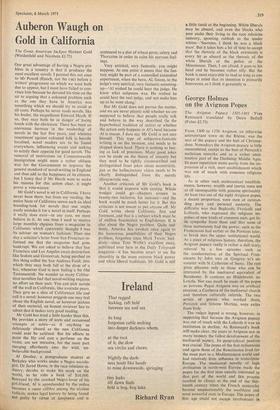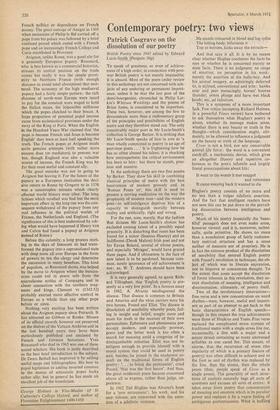George Holmes on the Avignon Popes
The Avignon Papacy 1305-1403 Yves Renouard translated by Denis Bethell (Faber £2.75)
From 1309 to 1376 Avignon, an Otherwise unimportant town on the Rhone, was the seat of the papacy and the hub of Christen- dom. Nowadays the Avignon papacy is little remembered, except as the butt of Petrarch's malicious remarks and as a rather unat- tractive part of the Declining Middle Ages. Its poor reputation stems partly from the im- pression of a rich, inert establishment which was out of touch with common religious life.
As in other such ecclesiastical establish- ments. however, wealth and inertia were not at all incompatible With genuine spirituality. At least two out of the eight Avignon popes, a decent proportion, were men of outstan- ding piety and personal austerity. The difficulty was that Beghtimis, Fraticelli and Lollards, who expressed the religious im- pulses of new kinds of common men, got lit- tle sympathy from them and that none of these movements had the power, such as the Franciscans had earlier or the Puritans later, to break into the upper institutional world. As a piece of religious history, therefore, the Avignon papacy really is rather a dull story, relieved by a few episodes such as the condemnation of the Spiritual Fran- ciscans by John xxti or Gregory xt's en- counter with St Catherine of Siena. The rest gives pleasure only to those who can be interested by the mediaeval equivalent of Barchester. It contains no Hildebrand, no Loyola. Nor can much be made of the popes as patrons. Papal Avignon was an artificial creation. a Canberra of the mediaeval church and therefore culturally infertile. The two artists of genius who worked there, Petrarch and Simone Martini, were exiles from Italy.
The vulgar legend is wrong, however, in supposing that because the Avignon papacy was out of touch with the Lollards it was an institution in decline. As Renouard's book will make clear, the years at Avignon saw in many respects the fullest development of the mediaeval papacy. Its geographical position was crucial. The popes of the first millennium and again those of the Renaissance lived for the most part in a Mediterranean world and had relatively little influence in transalpine Europe. The mediaeval novelty of high civilisation in north-west Europe made the popes for the first time equally interested in that part of the world and this process reached its climax at the end of the thir- teenth century when the French monarchy became unquestionably the wealthiest and most powerful state in Europe. The popes of that age could not escape involvement in
French politics or dependence on French money. The great outrage of Anagni in 1303 when emissaries of Philip le Bel carried off a pope from his palace was followed by a brief confused period which ended with a French pope and an increasingly French College and Curia established in Provence.
Avignon, unlike Rome, was a good site for a genuinely European papacy. Renouard, who is best known as a commercial historian, stresses its central position on the trade routes but really it was the simple proxi- mity to Northern France (with enough distance to avoid total absorption) that mat- tered. The economy of the high mediaeval papacy had a fairly simple pattern: the rich dioceses of north-west Europe were taxed to pay for the constant wars waged to hold the Italian states, the impossible millstone which the popes clutched to their breast. A large proportion of potential papal income came from ecclesiastical provinces under the sway of the King at Paris. When the English in the Hundred Years War claimed that 'the pope is become French and Jesus is become English' they were at least half speaking the truth. The French popes at Avignon made quite genuine attempts (with rather more success than UN mediators) to prevent war but, though England was also a valuable source of income, the French King was by far their most useful and constant ally.
The great mistake was not in going to Avignon but leaving it. For the future of the papacy as a European institution the deci- sive return to Rome by Gregory xi in 1376 was a catastrophic mistake which clearly affected world history ever after. The long Schism which resulted was bad but the most important effect in the long run was the con- sequent withdrawal of the papacy from any real influence in the political worlds of France, the Netherlands and England. (The significance of this is best understood by ask- ing what would have happened if Henry vin and Calvin had faced a papacy at Avignon instead of Rome) Before this calamity, a long process start- ing in the days of Innocent in had trans- formed the papacy into a supranational state with deep roots all over Europe in the form of powers to tax the clergy and determine the succession to many benefices. This kind of papalism, as Renouard shows, was helped by the move to Avignon where the bureau- crats could toil in peace safe from the quarrelsome nobles of Campagna- and in closer connection with the northern mag- nates and kings. Clement VI (1342-52) probably exerted more effective control in Europe as a whole than any other pope before or since.
Nothing very exciting has been written about the Avignon papacy since Petrarch. It has attracted no Gibbon or Ranke. Masses of its official records however are preserved on the shelves of the Vatican Archives and in the last hundred years they have been meticulously published and analysed by French and German historians. Yves Renouard who died in 1965 was one of these sound scholars. His book is justly described as the best brief introduction to the subject.
Dr Denis Bethell has improved it by adding useful maps and bibliographies. His bow to papal legitimism in adding inverted commas to the names of schismatic popes looks rather silly, but in general he has made an excellent job of the translation.
George Holmes is Vice-Master of St Catherine's College Oxford, and author of Florentine Enlightenment 1400-1450



































 Previous page
Previous page